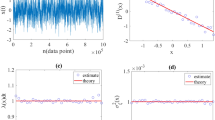Abstract
Stochastic models for phenomena that can exhibit sudden changes involve the use of processes whose sample functions may have discontinuities. This paper provides some tools for working with such processes. We develop a sample path formula for the cumulative jump height over a given time interval. From this formula an expression for the expected value of the cumulative jump random variable is developed under reasonable conditions. The results are applied to finding the expected number of failures in the separate maintenance model over a stated time interval and to the expected number of occurrences of a regenerative event over a stated time interval.
Similar content being viewed by others
Notes
Notice that Z(t)=1−J 0(t,Z).
This is not essential; all results continue to hold when Z(0)=0, provided appropriate changes are made.
References
Barlow, R. E., & Proschan, F. (1987). Classics in applied mathematics: the mathematical theory of reliability. Philadelphia: SIAM.
Baxter, L. A. (1981). Availability measures for a two-state system. Journal of Applied Probability, 18, 227–235.
Baxter, L. A. (1983). Availability measures for coherent systems of separately maintained components. Journal of Applied Probability, 20, 627–636.
Birolini, A. (1984). On the use of stochastic processes in modeling reliability problems. New York: Springer.
Bogdanoff, J. L., & Kozin, F. (1985). Probabilistic models of cumulative damage. New York: Wiley.
Friedrichs, K. O. (1944). The identity of weak and strong extensions of differential operators. Transactions of the American Mathematical Society, 55, 132–151.
Gertsbakh, I. B., & Kordonskiy, Kh. B. (1969). Models of failure. New York: Springer.
Karlin, S. M., & Taylor, H. M. (1975). An introduction to stochastic processes (Vol. 1). New York: Academic Press.
Kijima, M., & Suzuki, T. (2001). A Jump-diffusion model for pricing corporate debt securities in a complex capital structure. Quantitative Finance, 1(6), 611–620.
Kingman, J. F. C. (1964). The stochastic theory of regenerative events. Probability Theory and Related Fields, 2(3), 180–224.
Lee, S. S., & Mykland, P. A. (2008). Jumps in financial markets: a new nonparametric test and jump dynamics. The Review of Financial Studies, 21(6), 2535–2563.
Marlow, N. A., & Tortorella, M. (1995). Some general characteristics of two-state reliability models for maintained systems. Journal of Applied Probability, 32, 805–820.
Natanson, I. P. (1961). Theory of functions of a real variable. New York: Ungar.
Sobczyk, K., & Trebicki, J. (1989). Cumulative jump-correlated model for random fatigue. Engineering Fracture Mechanics, 40(1), 201–210.
Sobczyk, K., & Trebicki, J. (1991). Modeling of random fatigue by cumulative jump processes. Engineering Fracture Mechanics, 34(2), 477–493.
Thompson, W. A. Jr. (1981). On the foundations of reliability. Technometrics, 23(1), 1–13.
Tortorella, M. (2005). Numerical solutions of renewal-type integral equations. INFORMS Journal on Computing, 17(1), 66–74.
Tortorella, M., & Frakes, W. B. (2006). A computer implementation of the separate maintenance model for complex-system reliability. Quality and Reliability Engineering International, 22, 757–770.
Walter, G., & Blum, J. (1979). Probability density estimation using delta-sequences. The Annals of Statistics, 7(2), 328–340.
Whitt, W. (2002). Stochastic-process limits. New York: Springer.
Author information
Authors and Affiliations
Corresponding author
Additional information
The conception and beginning development of the material discussed in this paper is the work of my mentor, colleague, and dear friend Norman A. Marlow, who did not live to see the completion of the work as described here. I dedicate this paper to his memory.
Appendix
Appendix
In this appendix, we show how Marlow’s original computation generalizes to yield the number of jumps, regardless of size, of a cadlag+ step function.
Suppose 0=u 0<u 1<⋯<u n <t and \(f(x) = \sum_{i = 1}^{n} \alpha_{i}I_{ [ u_{i - 1},u_{i} )}(x)\) for x∈[0,t]. Then
because the integral over [u n ,t] is zero by virtue of f being a step function. Then this becomes
The integral from x to u i is zero because f(y)=α i for all y∈[u i−1,u i ). What remains is equal to

The first term is

As λ→+∞, the only term in the inner sum that survives is the j=i+1 term, and this is equal to
The second term is

and this term goes to zero as λ→+∞. Finally, we obtain
as desired.
Rights and permissions
About this article
Cite this article
Tortorella, M. On cumulative jump random variables. Ann Oper Res 206, 485–500 (2013). https://doi.org/10.1007/s10479-013-1319-2
Published:
Issue Date:
DOI: https://doi.org/10.1007/s10479-013-1319-2




